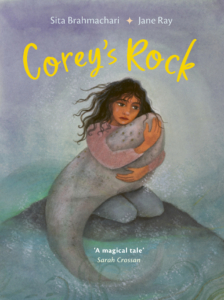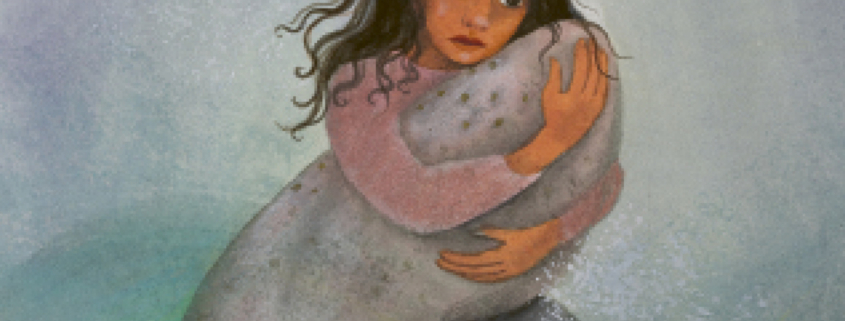Q&A with Sita Brahmachari and Jane Ray

Sita and Jane, In terms of developing the story, how easy was it to create both in terms of text and illustration?
Sita: Some stories you realise you have lived with for a long time and when you finally commit to writing them, they sort of sing through you. Corey’s Rock was like that in the writing. It is written in free verse and prose and it’s lilting, wave like feeling reflects how it felt to write.
I gave the manuscript to Jane soon after I met her. I remember Kate Agnew suggesting that a collaboration between us could be magical. Jane and I met at an event for Pop Up Festival, and we immediately connected. Soon after she invited me to work with her at The Refugee Centre in Islington, a collaboration as Artist and Writer in Residence that has become integral to all our work together. I told Jane I had written a Contemporary Selkie Tale, and she said she would love to read it. I was so excited when she told me that she was moved by the story and could see the images rising from the waves of words.
Jane: When someone has written a story very dear to their heart, and as an illustrator, you ask to see it, there is always, it has to be admitted, a moment of anxiety – what if it doesn’t touch me in any way? What if it does nothing for me? What if I don’t ‘get it’?
Of course, reading this manuscript for the first time was completely wonderful, and I had that sort of recognition – there was a familiarity in the setting, the story and the atmosphere. There are some writers who almost write the illustrations for you, and Sita is one such. She has a powerful visual imagination and as I read her words, I could see that place, see that bereaved and loving family, see the view from Corey’s Rock….
In addition Selkie stories have always fascinated me – I love folk tales, myths and legends, and have illustrated many over the years. I love the idea of contemporary fairy tales too, and have written them myself, ‘Can You Catch A Mermaid?’ being one. Making the magical contemporary sometimes makes it more accessible. I immediately took Corey’s Rock to my heart!
Sita, What is your writing process like? Do you have a more productive time of day? Do you need, treats or music to encourage you or do you have a “writing space”?
I am a morning person. I love to hear bird song drowning out the morning traffic. Birdsong is the best soundtrack to write to There is a dog called Sultan in Corey’s Rock. Sultan was our childhood dog. He once stayed beside my cousin when she got lost and accompanied her back home after a worrying length of time! Every morning I go for a walk with my dog Billie. It’s often on my walk that I will start to feel my way into writing. Sometimes problems that I have with a story are solved when I’m walking and away from the desk. After my walk I will sit down to write. I can write in different places. In my little shoe cupboard sized room with skylight windows or on the kitchen table. To be honest once I’m taken with the story and characters my writing location recedesand I am wherever my characters are in the story. This doesn’t always happen but when it does it is the most magical treat to swim in this place of creativity.
Jane: Mornings for me too! Breakfast, watching the birds feeding, a walk in the woods, listening and breathing in the fresh air, and a little wander round the garden to see what is coming up…
I do some stretches and I plan my day. All too often it starts with emails and admin, but as soon as I can, I get into my little studio at the end of the garden and get on with the real business of the day – making pictures!
When its warm enough I sit in the garden with my coffee, to rest my eyes and my back…
It’s a curious thing, but it is often when you are not at your desk that problems are solved. Washing up, or putting the food shop away are often the times when I’ll think most clearly about the next step in a picture.
I listen to music and the radio when I know what I’m doing with an illustration.When I’m working on roughs and ideas I need quiet, with a background of birdsong…
Jane, Your illustrations capture the beauty of the island landscape and integrate it perfectly with the atmosphere and rich texture of the storytelling, how did you research for this?
Thank you! I drew on all the memories I’ve described above, and filled a sketchbook with
drawings of pebbles, flowers, sea birds, shells, seals, rocksand rugged landscapes.
I made extensive use of Orkney websites, full of fascinating information and imagery about the ancient history, folklore, customs and traditions, as well as more ‘domestic’ detail and colour – such as tides, shop opening times, pubs, festivals and contemporary culture.
And some magical moments of connection – the discovery that the familiar Celtic knot design (pp42-43) deeply symbolic of Orcadian culture that Isla’s mother was born into, is also integral to the culture of the Yoruba people of Nigeria, where Isla’s father’s parents originate from, featuring in their exquisite traditional beadwork. A moment of deep satisfaction!
Sita and Jane, How does your collaboration work? What is the key to your communication in terms of bringing a picture book together?
Sita: Our collaboration varies on each book. However, Jane and I have worked on three stories now: Corey’s Rock. Worry Angels and Swallow’s Kiss.
With Corey’s Rock I handed over the MS and without any communication apart from the MS, Jane began to make sketches. Otter Barry Books were interested in commissioning the story. We live close by to each other and Jane invited me to her home to see the spreads of the images she’d created. It was a magical moment for me. I have long loved Jane’s work and I felt overwhelmed to see the story world and characters, that connected to my own childhood, materialise in the most lyrical and beautiful way. How I had longed as a child to see these pictures. I burst into tears. Jane was worried that the visual world she had created so sensitively and generously was ‘ ‘not right’. She had to put up with me trying to articulate just what it meant to me to not only see but feel (as if I was a young Isla) the joy of finding something of your own dreaming self in a book. It was a keen reminder and insight of the childhood self who felt absence and lack of belonging – who led me to write the books I’ve written for children today.
Our work at the Refugee Centre is integral to our lives and work. The celebration of the healing power of art and writing to express ourselves is our work with refugee people and it is also our work as author and illustrator creating stories for children. It’s a great joy that some of the artists and writers we’ve worked with are now being published in an international anthology ‘The Other Side of Hope.’
The Art Room in Worry Angels (Barrington Stoke) is the creative space we have created together. Swallow’s Kiss (Pop Up Projects) began in the art and writing room at the refugee centre after a session in which we made wishing birds together and wrote our hopes and dreams on ‘wishing wings’. ‘Worry Angels’ was sent by Book Aid International to children in refugee camps and ‘Swallow’s Kiss’ was chosen as London’s South Bank Centre’s Welcome Story for Good Chance Theatres giant refugee puppet Little Amal. The stories we have written together are a culmination of the deep understanding we have of collaborating over many years in community. However, Corey’s Rock was our first collaboration, and it was clear that our connection as writer and illustrator was one of a shared sensibility. We are both also immensely proud that the story has been endorsed by Amnesty International.
Jane: Every collaboration is different, but there is a rich creativity involved in working with Sita which is incredibly rewarding.
As she says, our work at the Refugee Centre is central to the books we create together, growing directly from the way we work with the Centre’s clients. It feels like a circular process – being inspired by the people we meet, and their creativity, which feeds into our work, which feeds back into the art and writing sessions with them….
The illustration of the Art Room in Worry Angels is based on the table that we work on together at the Centre, laden with paints, bright fabric, scissors, glue, flowers, bowls of fruit, pencils, feathers and rolls of paper! And the whole concept of Swallow’s Kiss was born of our teaching experience there.
The rest of life feeds into our work together too – a love of the natural world, of family and of home – the ‘shared sensibility’ that Sita talks of.
Sita and Jane, What do you hope readers will take from reading this story?
Sita: I hope it will speak to the power of stories and the imagination to help children and families navigate troubled times.
That it’s a story that speaks to universal themes of transformation, metamorphosis and the imagination; the ability to deal with huge changes and ignite empathy for those searching for stability, facing grief and starting life again in a new land.
That it will be a story that is shared, read out aloud and enjoyed across generations.
Jane: I hope it inspires quiet reflection, love of the natural world, recovery and connection…
Corey’s Rock by Sita Brahmachari and Jane Ray Published by Otter Barry Books . Paperback Out on February 16th 2023.
Views expressed do not necessarily reflect those of the Federation.




